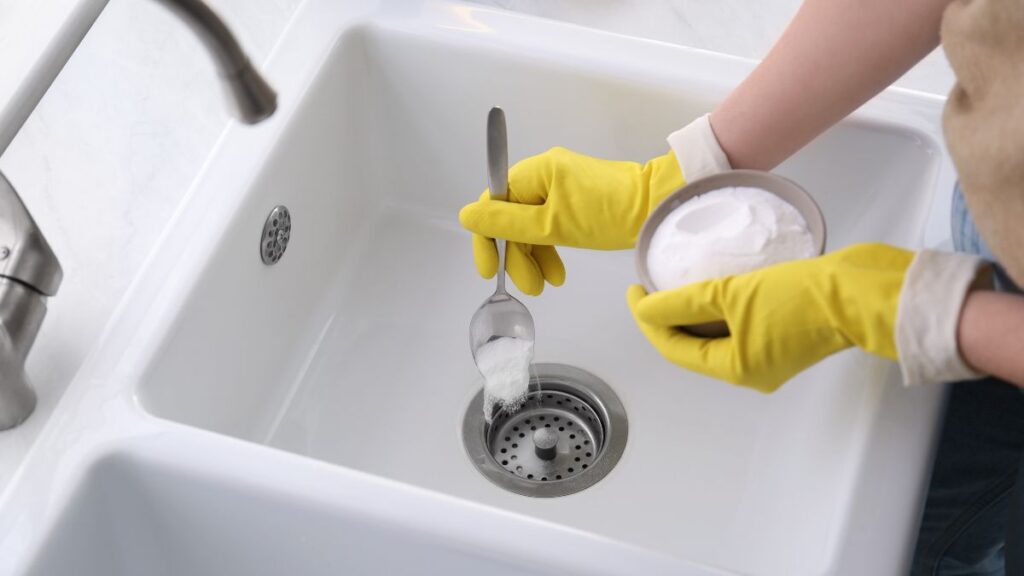
Funky odors wafting from your kitchen sink can put a damper on even the coziest home. For a fresh fix, a drain deodorizer using pantry staples works wonders. Instead of reaching for harsh products, a homemade method brings clean results with less effort.

Reusable Cleaning Cloths
Clean greener and smarter! Discover the best eco fabrics, care tips, and simple wins for reusable cleaning cloths.
Knowing how to whip up an effective drain deodorizer matters more than just for smells. It sidesteps tough chemicals, keeps pipe maintenance simple, and offers a budget-friendly cleaning habit. The results? Pipes stay fresher, and your kitchen stays inviting—all with everyday pantry items.
Ready to keep your drains in top shape and your space smelling pleasant? Dive into this guide for practical drain deodorizer formulas, time-saving prep steps, troubleshooting tips, and a handy comparison of common pantry ingredients.
Choosing the Right Pantry Staples for Effective Drain Freshening
Right from your kitchen cabinet, you can choose pantry staples that neutralize sink and tub odors. The goal: easy drain deodorizer success without fancy tools or specialty cleaners.
Baking soda leads the pack for natural drain deodorizer power. Its gentle abrasiveness and alkaline properties attack residue, while white vinegar reacts to help remove odor-causing grime. Adding salt or lemon offers more cleaning muscle and can mask odors nicely.
Pinpointing Baking Soda’s Cleaning Edge
Baking soda boasts fine grains that tackle buildup inside pipes, gently scrubbing away debris. Its fizz with vinegar lifts oily residues. To deodorize, pour a half cup down the drain and add hot water to push it deeper.
An example: “My drain started smelling stale, so I tossed half a cup of baking soda in and waited. After rinsing, the odor lifted, and the sink stayed fresh.” Copy this quick action anytime a musty scent appears.
If you notice sluggish drains, baking soda can help. Stick to twice-weekly treatments for maintenance, plus an extra dose after big cooking days or hosting guests. Consistency matters for the best drain deodorizer results.
Vinegar’s Double Role for Odor-Fighting
White vinegar breaks down mineral deposits and acts as a natural disinfectant. Pouring a cup of vinegar slowly after the baking soda creates gentle foaming that loosens clogs and improves drain deodorizer performance.
For deeper cleaning, cover the drain for 10 minutes after vinegar. The reaction fizzes as it works, so listen for a gentle sizzle—it’s a sign things are moving along.
Lemon juice or rind can follow vinegar for a citrus-fresh boost. Run hot water after to flush residues. This three-step method leaves pipes not just deodorized, but also sparkling clean and inviting.
| Ingredient | Primary Benefit | When to Use | Next Step |
|---|---|---|---|
| Baking Soda | Scrubs & Neutralizes Odor | Weekly or as needed | Flush with hot water |
| Vinegar | Breaks Down Residue | With baking soda for fizzing | Cover drain, wait, rinse |
| Salt | Boosts Scrubbing Power | With baking soda in tough drains | Add hot water rinse |
| Lemon | Masks Odors, Freshens Air | After vinegar, anytime for fresh scent | Add peel, then hot water |
| Boiling Water | Flushes Away Build-up | End of every process | Pour slowly, repeat if needed |
Action Steps for a Safe Drain Deodorizer Routine
Setting up a drain deodorizer routine means fewer surprise smells and smoother pipes. You’ll save money, avoid chemical exposure, and maintain a tidy kitchen in under ten minutes each week.
Kick things off by clearing visible debris from the drain opening. Next, pour half a cup of baking soda directly down the drain. Have your other ingredients ready for a seamless process.
Salt and Vinegar Combination in Action
Topping baking soda with a tablespoon or two of coarse salt enhances scrubbing as you pour in a cup of vinegar. It fizzes up, scours off gunk, and lifts grime stuck deeper down.
- Rinse first with hot water to loosen surface buildup before the drain deodorizer goes in. This step primes the pipe for better cleaning results.
- Add baking soda on dry pipes so it doesn’t dissolve right away. It should coat the inside for maximum odor control.
- Mix in salt for its grit. Swirl the mixture around with a spoon if necessary for even distribution.
- Pour vinegar slowly to activate fizzing. Allow reactions to bubble for at least ten minutes. Cover the drain to trap the cleaning power inside.
- Finish by flushing with boiling water, sending odor and loosened grime away. Repeat weekly as part of your drain deodorizer routine.
This routine tackles kitchen, bathroom, and laundry drains equally well. For most households, once-a-week sessions keep things under control and help avoid tough clogs later.
Adding Citrus for a Boost of Freshness
After the core ingredients, toss a handful of fresh lemon or orange peels down the drain. Follow with boiling water. The zesty aroma masks any remaining odors and gives a natural, pleasant scent boost.
- Shred peels first so they fit the drain and don’t clog. Peels break down gradually, releasing aromatic oils that linger long after cleaning.
- Run water while adding peels to prevent blockage. This distributes citrus oils for consistent freshness throughout the pipe.
- Schedule citrus freshening right after cooking fish or pungent foods. It quickly restores a neutral scent in your kitchen or bathroom.
- Rotate citrus types—try lemon one week, orange the next—to keep your drain deodorizer routine interesting and effective.
- Never overfill the drain with peels—just a small handful per session is perfect for results and safety.
Combining citrus with classic pantry items offers versatility and superior performance without relying on chemical store-bought solutions. Your home stays inviting and safe, week after week.
Timing, Frequency, and Professional Tricks for the Best Results
Consistency is key for any drain deodorizer routine. Weekly care sets the foundation, but you’ll want to bump up frequency after big meals, during humid spells, or if cooking produces lingering smells.
Choose a regular cleaning slot, such as Sunday night, when kitchen use wraps up. Make it a part of your broader cleaning rhythm, so it becomes second nature. Even pros set calendar reminders for their drain deodorizer treatments.
Shortcuts for Busy Households
If your schedule is tight, prep a mason jar with baking soda and salt blend. Keep it by the sink for quick access. In a pinch, sprinkle, add vinegar, and rinse with boiling water when rushing out the door.
For sudden odors, a spoonful of salt and a splash of hot vinegar do wonders. Allow it to sit until you return, then flush thoroughly. This emergency fix holds you over until a full cleaning.
Kids can help! Let them pour baking soda or drop in citrus peels. Supervising this hands-on task keeps drains fresher and helps establish lifelong cleaning habits for the whole family.
Cleaning Up After Special Occasions
After a dinner party or deep-fry session, odors settle in swiftly. Take five minutes before bed: run boiling water, pour baking soda and vinegar, then seal the drain with a cup. Flush in the morning for maximum odor removal.
Holiday cooking and houseguests put extra strain on drains. Double your drain deodorizer frequency that week. Make a checklist for yourself: baking soda, vinegar, citrus, rinse—repeat.
Don’t allow food scraps to linger in the drain basket. Clearing these out nightly keeps odors from returning. Treat the drain with your deodorizer blend while the memory of dinner cleanup is still fresh.
Conclusion: Savoring a Fresher, Simpler Home with Pantry Drain Deodorizers
Sticking to a pantry-based drain deodorizer plan gives your home a clean, lasting scent and reduces the need for daily scrubbing. You get results with minimal investment and effort, right from your own kitchen cabinets.
Each ingredient—baking soda, vinegar, salt, lemon, and boiling water—serves its own purpose. Routine use not only neutralizes odors but also helps maintain smooth-running pipes and a fresher environment.
Try these drain deodorizer steps today. Include the whole family in weekly clean-ups—turning chores into easy moments. Fresh-smelling drains transform your kitchen and bathroom into brighter, healthier spaces everyone can enjoy.
Frequently Asked Questions
For most households, once per week keeps drains fresh and prevents buildup. If strong odors recur, try twice weekly. After heavy cooking or lots of guests, add an extra deodorizing step to keep up.
Baking soda combined with vinegar is most effective for tough odors. Salt can add extra scrubbing pressure. Follow by citrus peels for lingering freshness and to mask stronger, persistent drain smells.
Avoid mixing strong commercial cleaners with natural items like vinegar and baking soda. Stick to one routine for safety. Never pour fats or grease down the drain, as these can cause bigger odor issues and stubborn clogs.
Homemade cleaners excel at routine maintenance and minor odors. For persistent blockages, slow drainage, or foul smells that won’t clear, consult a professional plumber. DIY solutions handle small issues, but regular checkups ensure long-term pipe health.
Baking soda and vinegar are generally safe for most home plumbing, including PVC and metal pipes. Boiling water works well, but check for manufacturer restrictions in older homes before regular use to avoid unintentional pipe damage.

Composting Basics for Everyday Kitchen Scraps
Turn scraps into soil! Learn composting basics to recycle kitchen waste and create nutrient-rich compost at home.


